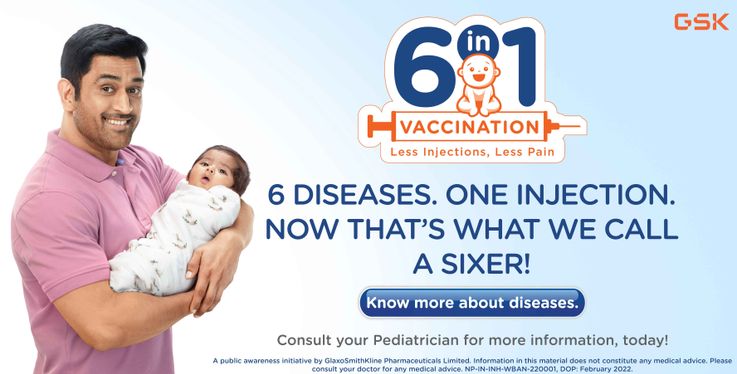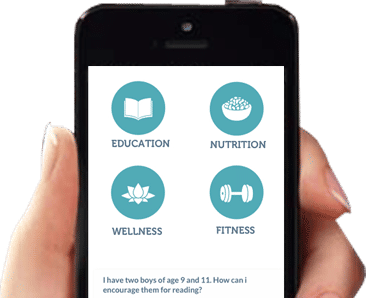
What every parent needs to know about 6 in 1 Vaccination
“less injections and more protection for babies"
What is 6 in 1 vaccination?
6 in 1 is a combination vaccination, which protects babies against 6 diseases in a single shot. [Diphtheria, tetanus, pertussis (whooping cough), poliomyelitis, Haemophilus influenza type B and hepatitis B] Children get fewer injection pricks, but protection achieved is same as they would have with separate vaccines.
What are the benefits of 6 in 1 vaccination?
Benefits for Children
- - On-time protection
- - Less injection pricks
- - Less pain of multiple injections and discomfort
Benefits for Parents
- - Less inconvenience
- - Fewer visits to Pediatrician
- - Less time off from work or family activity
When should my child receive 6 in 1 vaccination?
For the right schedule of 6 in 1 vaccination please consult your Pediatricians.
Are there any additional side effects with combination vaccination vs separate vaccines?
Side effects from combination vaccines are generally similar to those of the individual vaccines given separately and usually mild. There may be slightly more pain or swelling where the shot was given with combination vaccination. But if your child got the injections individually, he or she might have pain or swelling in two or three spots, instead of just one. If your child has moderate or serious side effects from any vaccine, inform your Paediatrician.
GSK's 6 in 1 vaccination awareness initiative
Dhoni joins GSK India's awareness initiative to help infants hit a 6!
6 Diseases That May Put Newborns At Risk

Polio
What is Polio and how can my baby catch it?
Polio is a highly infectious disease caused by a virus. It infects the nervous system, and can cause paralysis, difficulty breathing and sometimes even death. Polio mainly affects children under 5 years of age and is highly contagious. It spreads from person-to-person mainly through feco-oral route or by a common vehicle (for example, contaminated water or food). Also, if your child puts objects like toys that have been contaminated into their mouth, they can get infected.
What would happen if my baby got Polio?
As per CDC, about 1 out of 4 people with Poliovirus infection will have flu like symptoms which may include sore throat, fever, tiredness, nausea, headache and stomach pain. A proportion of patients can develop symptoms involving brain and spinal cord. Paralysis is the most severe symptom associated with polio. It can lead to permanent disability and death.
What are the ways to protect my newborn from Polio?
The most effective way to prevent polio is vaccination. Other measures include good sanitation and proper hygiene. Talk to your doctor about more information on vaccination against Polio.
Diphtheria
What is Diphtheria and how can my baby catch it?
Diphtheria is a serious bacterial infection that usually affects the mucous membranes of nose and throat.Diphtheria spreads usually through:
- Respiratory droplets from an infected person’s coughing or sneezing.
- Close contact with infected open sores or ulcers
What would happen if my baby got Diphtheria?
Diphtheria symptoms include weakness, sore throat, fever & swollen glands in the neck. A thick coating could form in the throat that can lead to difficulty in breathing or swallowing along with complications like blocking of airway, heart damage, nerve damage, lung infection and paralysis.
How can I protect my baby from Diphtheria?
Diphtheria is preventable with vaccination. The diphtheria vaccine is usually combined with vaccines for tetanus and whooping cough (pertussis). The diphtheria vaccine in combination with other antigens is one of the childhood immunizations that doctors recommend during infancy.
One must ensure all hygienic precautions including keeping baby away from any person who is sick.
Pertussis
What is Pertussis and how can my baby catch it?
Pertussis (also known as whooping cough) is a highly contagious respiratory infection which can be very serious, especially for newborn babies and young infants.
Pertussis is spread through the air by infectious droplets, so it is easily transmitted by other people coughing or sneezing or being close to a person with the disease. Mothers are the main source of Pertussis infection for newborns.
What would happen if my baby got Pertussis?
Pertussis can cause serious complications in babies and young infants less than 2 months of age. Infants and young children can be distressed and may turn blue due to difficulty in breathing.
What are the ways to protect my newborn from Pertussis?
Pertussis can be prevented by vaccinating the infant. Other strategies to prevent Pertussis in young infants includes vaccination of mothers, family members and close contacts. Other measures include isolation from the infected person. Please contact your doctor for more details.
Tetanus
What is Tetanus and how can my baby catch it?
Tetanus is an acute, often fatal disease caused by the bacterium Clostridium tetani. it is characterized by general rigidity and spasms of skeletal muscles.
The muscle stiffness usually involves the jaw (lockjaw) and neck and then may spread to the entire body.
The bacteria spores are usually found in soil, dust and manure and enter the body through breaks in the skin - usually cuts or puncture wounds caused by contaminated objects.
What would happen if my baby got Tetanus?
In neonatal tetanus, symptoms include muscle spasms, which are often preceded by the newborn’s inability to suck or breastfeed and excessive crying.
In older children and adults, it can lead to cramping of jaw, painful tightening of muscles and seizures. This can lead to complications like broken bones, breathing difficulty, spasm in the vocal cords.
What are the ways to protect my newborn from Tetanus?
CDC recommends vaccination, good wound care, and maintenance to help prevent tetanus infection. Doctors can also use a medicine to help prevent tetanus in cases where someone is seriously hurt and has not been vaccinated for Tetanus.
Haemophilus Influenzae Type b (Hib)
What is Haemophilus influenzae type b and how can my baby catch it?
Haemophilus influenzae disease is caused by a bacteria called H. influenzae.
In spite of the name, H. influenzae does not cause influenza (the flu). Haemophilus influenza type b (Hib) is a bacteria that can cause many different kinds of infections ranging from mild ear infections to severe pneumonia, meningitis and other invasive diseases almost exclusively in children aged less than 5 years.
People can spread H. influenzae, including Hib, by coughing or sneezing while in close contact with others. Even people who may not look sick can have the bacteria in their noses and throats and may spread the bacteria.
What would happen if my baby got Hib?
The most common invasive diseases caused by Hib include Pneumonia, Bloodstream infection and Meningitis. Meningitis is an infection of the covering of the brain and spinal cord. It can initially present with high fever, headache, poor eating & drinking.
As per CDC, most children with Hib invasive disease need care in the hospital. Even with treatment, as many as 1 out of 20 children with Hib meningitis die. As many as 1 out of 5 children who survive Hib meningitis can have brain damage or become deaf.
What are the ways to protect my newborn from Hib disease?
WHO recommends vaccination as the only public health tool capable of preventing the majority of serious Hib disease. Hib vaccines are considered safe and efficacious even when administered in early infancy. Other preventive measures include good sanitation and proper hygiene.
Hepatitis B
What is Hepatitis B and how can my baby catch it?
Hepatitis B is an infection of the liver caused by a virus that's spread through blood and body fluids. Hepatitis B can range from a mild short-term illness to a serious, lifelong illness in children. It can often persist for years and may eventually cause serious liver damage.
An infected mother can pass on the infection to her baby during birth. The hepatitis B virus is spread when blood, semen, or other body fluid infected with the hepatitis B virus enters the body of a person who is not infected.
What would happen if my baby got Hepatitis B?
As per CDC, about 30%-50% of people aged 5 years and older have symptoms from acute hepatitis B. Most children under 5 years old and people with serious health problems, such as being immunosuppressed, generally do not have symptoms.
Symptoms of hepatitis B include tiredness, fever, loss of appetite, nausea, yellowing of skin or eyes, abdominal pain and dark urine.
Approximately 90% of infected infants (i.e. children less than 1 year of age) will develop chronic infection. The risk goes down as a child gets older. Approximately 25%–50% of children infected between the ages of 1 and 5 years will develop chronic hepatitis B.
Chronic hepatitis B can cause liver damage, cirrhosis, liver cancer and even death.
What are the ways to protect my newborn from Hepatitis B?
As per CDC, best way to prevent hepatitis B is by getting vaccinated. Completing the series of shots is needed for full protection. Other preventive measures include avoiding blood and bodily contact with the infected person. Talk to your doctor about more information on vaccination against Hepatitis B.
Disclaimer: A public awareness initiative by GlaxoSmithKline Pharmaceuticals Limited. Dr. Annie Besant Road, Worli, Mumbai 400 030, India.
Information appearing in this material is for general awareness only. Nothing contained in this material constitutes medical advice. Please consult your doctor for any medical queries, any question or concern you may have regarding your condition. The disease list indicated for vaccination is not complete, please consult your child’s Paediatrician for the complete vaccination schedule. The doctor shown in this material is being used for illustrative purpose only and is a professional model. The disease representation icons/images and animation are for illustrative purpose only.
CL Code : NP-IN-INH-WCNT-220013, DOP February 2022

{{trans('web/app_labels.text_some_custom_error')}}
{{trans('web/app_labels.text_some_custom_error')}}

